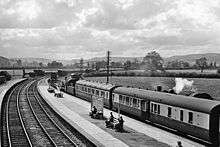Newtown and Machynlleth Railway
| Newtown and Machynlleth Railway | |
|---|---|
 Moat Lane Junction, a joint station with the Llanidloes and Newtown Railway. The N&MR to the Cambrian Mountains and Cardigan Bay proceeds ahead, the L&NR to Builth Wells proceeds to the left. Two LMS Ivatt Class 2 2-6-0's work within the station, 11 May 1957. | |
| Overview | |
| System | Cambrian Railways |
| Status | Operational, Cambrian Line |
| Locale | Mid Wales |
| Termini |
Newtown (Powys) Machynlleth |
| Stations | Scafell Halt, Moat Lane Junction, Caersws, Pontdolgoch, Carno, Talerddig, Llanbrynmair, Commins Coch Halt, Cemmes Road |
| Operation | |
| Opened | 1863 |
| Owner |
Original: Newtown and Machynlleth Railway Current: Network Rail |
| Operator(s) |
Original: Cambrian Railways Current: Arriva Trains Wales |
| Technical | |
| Line length | 23 mi (37 km) |
| Track gauge | 1,435 mm (4 ft 8 1⁄2 in) |
The Newtown and Machynlleth Railway (N&MR) was a short railway created to allow the Oswestry and Newtown Railway and the Mid-Wales Railway access to the Mid-Wales market town of Machynlleth, from their communal station at Newtown, Powys. Crossing the River Severn and the Cambrian Mountains, it was completed in 1863 and became part of the Cambrian Railways system in 1864.
Construction

The railways of Wales were built by a series of ad hoc companies, often backed by a network of local and national investors, and engineered by a group of communal civil engineers.
The difficulty with the construction of the N&MR, was geographic over any other obstacle. Firstly, exiting Newtown, all routes had to cross the River Severn. Secondly, then heading due west, the railway had to make an economic and accessible to railway locomotives crossing of the Cambrian Mountains. This made the shortest but direct route both difficult to construct, resultantly expensive and potentially unworkable. This was much like the dilemma which resulted in the economic termination of the strategic route which was the Llangurig branch of the Manchester and Milford Railway.

Vested by an Act of Parliament on 27 July 1857, by the start of construction in 1860, the Llanidloes and Newtown Railway had already bridged the River Severn south of Newtown, leaving the N&MR to only need to construct the twin spans of Penstrowed bridge to head west. After a junction with the Van Railway at Caersws, the line then followed the natural line of the rising ground up towards the village of Talerddig, where Talerddig cutting enabled the railway to cross the Cambrian Mountains. Now heading gently down hill along the course of River Twymyn towards the coast at Cardigan Bay, via a junction with the Mawddwy Railway at the Anglicanised-named Cemmes Road, the line terminated at Machynlleth. Even though it was single track, economic control of all costs created a meandering path, but low cost of construction of the line.
Talerddig cutting

A significant civil engineering achievement on the line is the Talerddig cutting through solid rock. With a depth of 120 feet (37 m), it was the deepest cutting in the world at the time of its completion in 1862. For safety reasons, the original near-vertical sides have since been trimmed back.[1][2]
Machynlleth station

The first railway station in Machynlleth was the narrow gauge Corris Railway, which opened its station building on the north side of the main-line goods yard in 1859. This was later made accessible from the mainline station by a flight of steps from the standard gauge platform.
The N&MR arrived in Machynlleth in 1863, three years after the formation of the Cambrian Railways. As allowed by its Act of Parliament, the N&MR was instructed to build a station capable of connecting to the towns of Cardigan Bay via the 1861 authorised Aberystwyth and Welsh Coast Railway (A&WCR). This it did the following year, connecting Dovey Junction to Aberystwyth. In 1867 the A&WCR was extended from Barmouth to Pwllheli via Porthmadog (then Portmadoc).
Newtown and Machynlleth Railway | |||||||||||||||||||||||||||||||||||||||||||||||||||||||||||||||||||||||||||||||||||||||||||||||||||||||||||||||||||||||||||||||||||||||||||||||||||||||||||||||||||||||||||
|---|---|---|---|---|---|---|---|---|---|---|---|---|---|---|---|---|---|---|---|---|---|---|---|---|---|---|---|---|---|---|---|---|---|---|---|---|---|---|---|---|---|---|---|---|---|---|---|---|---|---|---|---|---|---|---|---|---|---|---|---|---|---|---|---|---|---|---|---|---|---|---|---|---|---|---|---|---|---|---|---|---|---|---|---|---|---|---|---|---|---|---|---|---|---|---|---|---|---|---|---|---|---|---|---|---|---|---|---|---|---|---|---|---|---|---|---|---|---|---|---|---|---|---|---|---|---|---|---|---|---|---|---|---|---|---|---|---|---|---|---|---|---|---|---|---|---|---|---|---|---|---|---|---|---|---|---|---|---|---|---|---|---|---|---|---|---|---|---|---|---|---|
Legend
| |||||||||||||||||||||||||||||||||||||||||||||||||||||||||||||||||||||||||||||||||||||||||||||||||||||||||||||||||||||||||||||||||||||||||||||||||||||||||||||||||||||||||||
History
In July 1864 the line was absorbed into the Cambrian Railways.[3] Cambrian Railways were absorbed by the Great Western Railway on 1 January 1922 as a result of the Railways Act 1921, and became part of British Railways in 1948.
There was an accident in the Talerddig cutting on 18 January 1921, of which several pictures survive. Hence, even since the first track rationalisation of the line during the 1970s, there remains to this day a passing loop on this single track line at the site of Talerddig station, retained in the need to "pin down" the brakes on freight trains over the summit, and now a critical operational node for passing passenger trains.[4]
Present
Today, after the closure during the Beeching Axe of much of the former-Cambrian system, the entire length of the N&MR remains open as part of Network Rail's Cambrian Line, operated by the Class 158 DMUs of Arriva Trains Wales.
References
- ↑ C P Gasquoine (1973). The Story of the Cambrian. Christopher Davies Ltd.
- ↑ "National Museum Wales". Retrieved 4 December 2010.
- ↑ Christiansen, Rex & Miller, R.W. The Cambrian Railways, Vol. 1 David & Charles (1967); p 65
- ↑ Carno Station Action Group, Talerddig Passing Loop
External links
- Newtown and Machynlleth Railway @ RailBrit.co.uk
- 1921 rail crash at Talerddig cutting: Picture 1, Picture 2, Picture 3